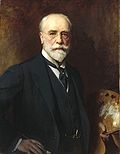 |
This is a file from the Wikimedia Commons. Information from its description page there is shown below.
Commons is a freely licensed media file repository. You can help.
|
Summary
| Artist |
|
| Description |
Portrait of King Edward VII (1841-1910)
|
| Date |
1902 replica of 1901 portrait |
| Medium |
oil on canvas |
| Current location |
National Portrait Gallery   |
 |
| Native name |
National Portrait Gallery |
| Location |
London |
| Coordinates |
51° 30′ 33.73″ N, 0° 7′ 39.84″ W   |
| Established |
1856 |
| Website |
www.npg.org.uk |
| Authority control |
|
|
|
|
| Accession number |
1691 |
| Object history |
given to the National Portrait Gallery, London in 1912. See source website for additional information. |
| Source/Photographer |
National Portrait Gallery, London: NPG 1691

|
While Commons policy accepts the use of this media, one or more third parties have made copyright claims against Wikimedia Commons in relation to the work from which this is sourced or a purely mechanical reproduction thereof. This may be due to recognition of the " sweat of the brow" doctrine, allowing works to be eligible for protection through skill and labour, and not purely by originality as is the case in the United States (where this website is hosted). These claims may or may not be valid in all jurisdictions. As such, use of this image in the jurisdiction of the claimant or other countries may be regarded as copyright infringement. Please see Commons:When to use the PD-Art tag for more information.
See User:Dcoetzee/NPG legal threat for more information.
This tag does not indicate the copyright status of the attached work. A normal copyright tag is still required. See Commons:Licensing for more information.
|
This set of images was gathered by User:Dcoetzee from the National Portrait Gallery, London website using a special tool. All images in this batch have been confirmed as author died before 1939 according to the official death date listed by the NPG. |
Licensing
This is a faithful photographic reproduction of an original two-dimensional work of art. The work of art itself is in the public domain in its source country for the following reason:
| Public domainPublic domainfalsefalse |
 |
This work is in the public domain in those countries with a copyright term of life of the author plus 80 years or less.
 You must also include a United States public domain tag to indicate why this work is in the public domain in the United States. Note that Mexico has a term of 100 years and does not implement the rule of the shorter term, so this image may not be in the public domain in Mexico. Côte d'Ivoire has a general copyright term of 99 years, but it does implement the rule of the shorter term. You must also include a United States public domain tag to indicate why this work is in the public domain in the United States. Note that Mexico has a term of 100 years and does not implement the rule of the shorter term, so this image may not be in the public domain in Mexico. Côte d'Ivoire has a general copyright term of 99 years, but it does implement the rule of the shorter term.
català | česky | Deutsch | English | español | suomi | français | עברית | italiano | 日本語 | 한국어 | lietuvių | മലയാളം | македонски | Plattdüütsch | Nederlands | norsk nynorsk | norsk bokmål | polski | português | русский | slovenščina | српски / srpski | svenska | 中文(繁體) | +/−
|
|
This file has been identified as being free of known restrictions under copyright law, including all related and neighboring rights.
|
The work of art itself is in the public domain in the United States for the following reason:
| Public domainPublic domainfalsefalse |
 |
This work is in the public domain in the United States because it was published (or registered with the U.S. Copyright Office) before January 1, 1923. Public domain works must be out of copyright in both the United States and in the source country of the work in order to be hosted on the Commons. If the work is not a U.S. work, the file must have an additional copyright tag indicating the copyright status in the source country.
|
The official position taken by the Wikimedia Foundation is that faithful reproductions of two-dimensional public domain works of art are public domain, and that claims to the contrary represent an assault on the very concept of a public domain. For details, see Commons:When to use the PD-Art tag.
This photographic reproduction is therefore also considered to be in the public domain. Please be aware that depending on local laws, re-use of this content may be prohibited or restricted in your jurisdiction. See Commons:Reuse of PD-Art photographs.
|
File usage
The following pages on Schools Wikipedia link to this image (list may be incomplete):
Wikipedia for Schools is designed to make learning fun and easy. More than 2 million people benefit from the global charity work of SOS Childrens Villages, and our work in 133 countries around the world is vital to ensuring a better future for vulnerable children. Will you help another child today?






